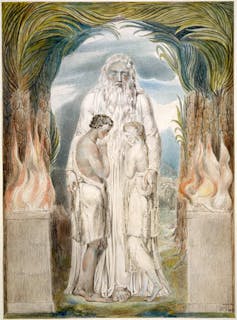

Caroline Kline, Claremont Graduate University
Discussions about women in the Church of Jesus Christ of Latter-day Saints, also known as the LDS church or Mormon church, often revolve around one question: Will they ever be ordained?
Latter-day Saint women may serve as leaders of women’s or children’s organizations, but power in the church remains firmly in the hands of men.
In my research on Mormonism and gender, however, I’ve studied how women’s status and leadership have noticeably increased within Latter-day Saint families since the 1980s.
This change is significant, given the importance of the family in the church’s teachings. Latter-day Saints believe that families continue to be together beyond this life, and that familial relationships shape their destinies after death.
Two centuries of change
Unlike many churches, the LDS church does not employ paid, full-time clergy at the local level. Instead, all practicing men and boys are ordained into a lay priesthood, usually around age 12. Priesthood holders can lead local congregations as bishops and bishops’ counselors. Depending on their status within the priesthood hierarchy, boys and men can officiate in baptisms and Holy Communion, which is called the “sacrament.”
Women of all ages, however, are barred from ordination and therefore barred from serving as bishops, apostles and prophets, among other types of leaders. In recent years, a grassroots movement called Ordain Women has pushed to extend the priesthood to women. However, senior church leaders have held firm that “the divinely decreed pattern” is for only men to be ordained, as one apostle of the church said in 2014. They emphasize that the blessings of the priesthood are available for everyone, including women and children.
The LDS church was founded in 1830, at a time when most Christian groups in the United States emphasized men’s “headship” or predominance in the family. Early Latter-day Saint leaders echoed these ideas and likewise affirmed male superiority.
Throughout the 20th century, LDS leaders often used the word “preside” to describe their vision of men’s leadership role in the family, which, up to the 1970s, emphasized their prerogatives to be the ultimate decision makers.
But the 1980s and 1990s saw the beginnings of a noticeable softening in leaders’ rhetoric about male “headship.” Increasingly, notions of men’s presiding within the family were coupled with messages about equal partnership between husbands and wives. Sermons from church leaders began to emphasize the importance of joint decision making, compromise and working together within marriage.
This shift toward a double discourse – one that simultaneously affirms male headship and egalitarianism in marriages – is reflected in the 1995 document known as “The Family: A Proclamation to the World.” The proclamation laid out the church’s official stance on family and gender roles. It states that “fathers are to preside over their families in love and righteousness and are responsible to provide the necessities of life and protection for their families. Mothers are primarily responsible for the nurturing of children. In these sacred responsibilities, fathers and mothers are obligated to help one another as equal partners.”
Many Latter-day Saints consider it to be a divinely inspired document.
Balancing act
How does a religion simultaneously emphasize both of these ideas: that men should preside and that men and women should be equal partners? How does a Latter-day Saint couple uphold both these visions of power dynamics within the home?
Part of the answer is in how the church has redefined the term “preside.” The church’s 2006 Family Guidebook describes male “presiding” as leading religious training and rituals within the family. Presiding was no longer attached to male decision making; rather, it involved proactive participation within the family.
Even more recently, the concept of male presiding has been reinterpreted to simply mean that fathers need to make sure the whole family is happy and thriving and that decisions are made mutually with both partners’ full participation.
Another way LDS teachings have accommodated egalitarian ideas is by reinterpreting the role of Eve – the first woman on Earth, according to the Bible.

Throughout the church’s history, messages about Eve have reflected evolving understandings of women’s roles. In the 19th century, Latter-day Saints, like most other Christian traditions, used the curse God placed on Eve – that her husband would rule over her – to justify female subordination.
Leaders in the early and mid-20th century downplayed the curse and evoked Eve as a noble model of what they considered women’s main purpose in life: to become mothers. And in the late 1970s, then-president of the church Spencer W. Kimball, while speaking about Eve, rejected the starkly patriarchal concept of men ruling over wives, saying he preferred the softer term “preside.”
Leaders in the 2000s have continued to reinterpret the story of Adam and Eve in increasingly egalitarian ways. Church leader Bruce Hafen sees Adam and Eve as “equal partners.”
This focus on Eve to justify newer ideas of women’s leadership within their families – though still couched within concepts of men’s “presiding” – is especially meaningful given Latter-day Saints’ emphasis on the story of Adam and Eve. During a major rite in church members’ lives, called the temple endowment ceremony, participants reenact part of the story, with men taking on Adam’s role and women Eve’s.
[There’s plenty of opinion out there. We supply facts and analysis, based in research. Get The Conversation’s Politics Weekly.]
In 2019, leaders changed the part of the ceremony where women made an obedience covenant, promising to “hearken” unto their husbands in righteousness – which had been one of the last and most significant ways the church stressed men’s predominance in the family. In a nod to rising egalitarianism, women now make a covenant to obey God directly. Husbands no longer serve as middlemen between wives and the divine.
The next generation
This momentous change to the temple ceremony signaled the death knell for older Latter-day Saint concepts of female subordination within marriage. Tellingly, however, church leaders have doubled down on language of male “presiding,” even if it does not mean so much in practice. The same year the women’s temple covenant was changed, church authorities added a reference to male “presiding” to the marriage ceremony.
The Latter-day Saint tradition continues, therefore, to embrace a double discourse of male headship and marital egalitarianism. For many Latter-day Saint feminists, this discourse is disingenuous and unsatisfying. These progressives desire teachings about marriage that better fit the new egalitarian ideals espoused by church leaders.
While leaders are clearly in no hurry to step away from talk of male “presiding,” one important outcome of the shift toward egalitarian rhetoric may be increasing male participation in the home. As fathers step into active, nurturing roles, a new generation of Latter-day Saint couples may increasingly live out a theology closer to equal partnership.
Caroline Kline, Assistant Director of the Center for Global Mormon Studies, Claremont Graduate University
This article is republished from The Conversation under a Creative Commons license. Read the original article.



















